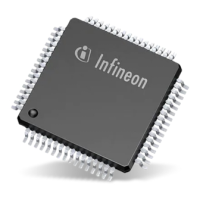Introduction to Digital Power Conversion
XMC4000/1000 Family
Comparison of Power Conversion Methods
Application Guide 15 V1.0, 2015-01
2.4.1.4 PWM Generation
The XMC CAPCOM Units (CCU4 or CCU8) timer slices can be regarded as “timer-cells” that can
cooperate and fit together like “puzzle pieces” to form matrices of sophisticated and compound timing
functions. These can interact for certain function request events and event profile conditions.
Theoretically, any on-chip module can be considered to act on a slice via one of (up to 3) inputs. A
flexible library of modular timing control applications (PWM “Apps”) can be created and then be
reused across projects.
The XMC single and multi-channel PWM drive capabilities include:
Global Synchronization
− to ensure a fully synchronized start with any combination of CAPCOM units
PWM
− by Symmetric / Asymmetric Modulation (Edge-Aligned or Center-Aligned)
− with Active / Passive Output Level Control / Trap Handling Protocol in hardware
− with Dithering (4 bits)
− by Status Events (by Compare or Period-Control)
− by external Set/Clear (by various conditional Start/Stop functions, which can be combined with
Status Events)
− by Matrix Interactions (on specific function request events and event profile conditions)
Examples
Peak, Valley or Hysteretic On-Off PWM
Fixed-On-TIme (FOT) PWM
Fixed-Off-TIme (FOFFT) PWM
Phase-Shift / Fixed Phase-Shift (Interleave) PWM
Half Bridge (HB) control with optional Synchronous-Rectification (SR)
Full Bridge (FB) control (w/ SR)
HB / FB Drive of LLC Resonance Converters
HRPWM Attributes
High Resolution Control (HRC) Insertion – down to 150 ps accuracy:
- HRC can handle switch frequencies up to 5 MHz with 10 bit resolution PWM
- Highly Accurate Low-Load Scenario Control
- Converter Efficiency Improvement: Each HRC can operate with two set of resources
Dead Time Insertion, with “On-the-Fly” optimization during run-time.

